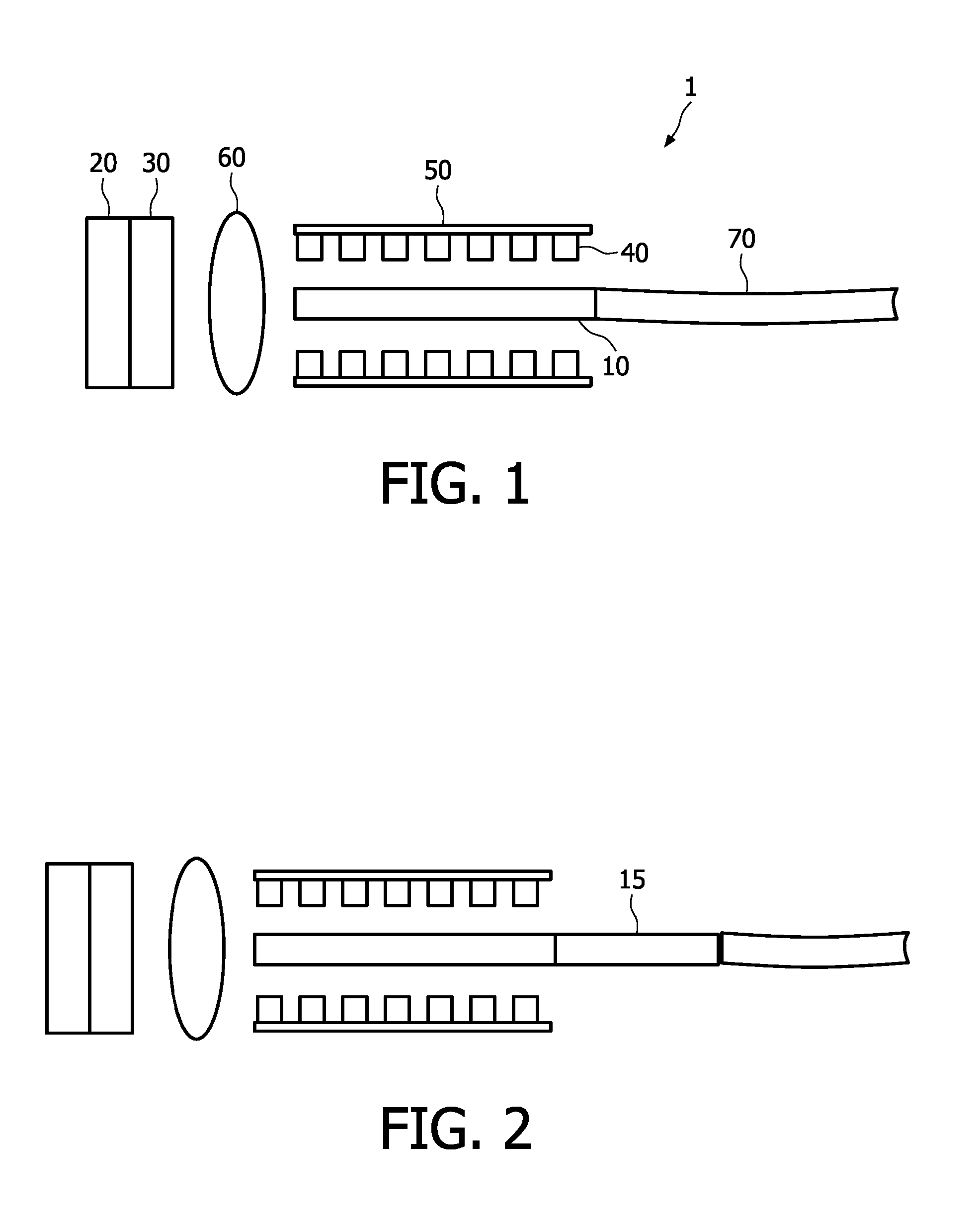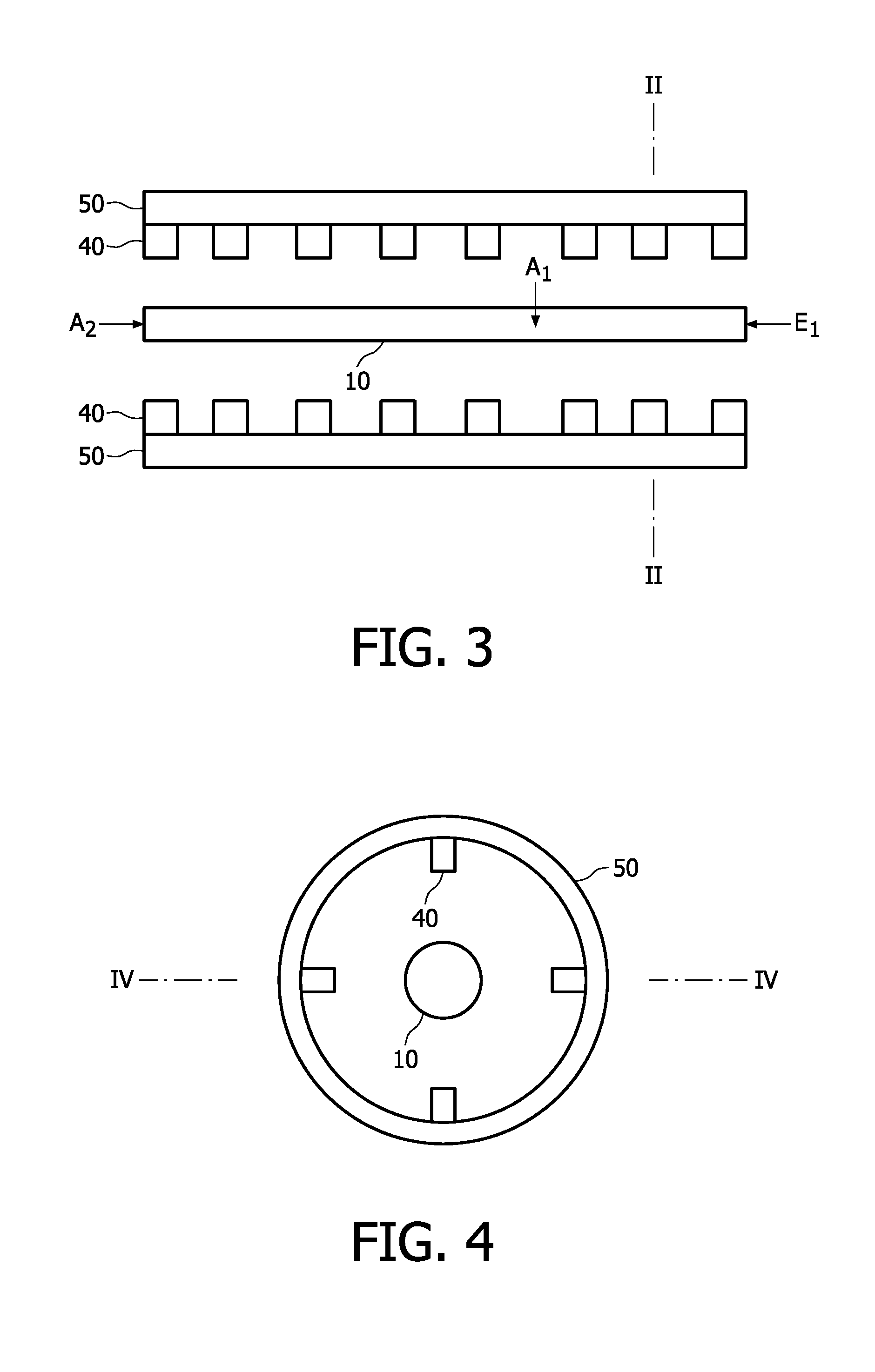Light emitting device with ceramic conversion material
a technology of light-emitting devices and conversion materials, which is applied in the direction of printers, instruments, therapy, etc., can solve the problems of inability to maintain the light flux, the color temperature of the light cannot be changed without deterioration, and the light cannot shift to the red. achieve the effect of maintaining or maintaining
- Summary
- Abstract
- Description
- Claims
- Application Information
AI Technical Summary
Benefits of technology
Problems solved by technology
Method used
Image
Examples
example i
[0083]In Example I, a light delivery device with the setting of FIG. 1 was used. The first LED (reference no. 20 in FIG. 1) was a InGaN LED with a peak emission at 462 nm, the first converter substance (reference no. 30 in FIG. 1) was a YAG:Ce ceramic material with the composition Y(3-x-y)GdxAl5O12:Cey with x=0.3 and y=0.06.
[0084]The conversion element (reference no. 10 in FIG. 1) was Y2O3:Eu with a 7% Europium doping and a density of 5.029 g / cm3.
[0085]The light delivery device furthermore comprises two sets of auxiliary LEDs (reference no. 40 in FIG. 1), which are also InGaN LEDs. Each set of LEDs has a power of 100% of the first LED and a peak emission at 465 nm.
[0086]FIGS. 5 and 6 show the spectra of the light delivery device with the first LED only (“LED”), with one set of auxiliary LEDs switched on (“Aux1”) and with both sets of auxiliary LEDs switched on (“Aux2”).
[0087]The data of FIGS. 5 and 6 are listed in Table I
[0088]
TABLE ILEDAux1Aux23800.001880.002380.002883820.0017390.0...
example ii
[0093]In Example II, a light delivery device with the setting of FIG. 1 was used. The first LED (reference no. 20 in FIG. 1) was an InGaN LED with a peak emission at 462 nm, the first converter substance (reference no. 30 in FIG. 1) was a YAG:Ce ceramic material with the composition Y(3-x-y)GdxAl5O12:Cey with x=0.3 and y=0.06.
[0094]The conversion element on Example II is CaS:Eu with 0.1% Europium.
[0095]The light delivery device furthermore comprises two sets of auxiliary LEDs (reference no. 40 in FIG. 1), which are also InGaN LEDs emitting at 450 nm. Each set of LEDs has a “strength” of 50% of the first LED.
[0096]FIG. 7 shows the spectra of the light delivery device with the first LED only (“LED”), with one set of auxiliary LEDs switched on (“Aux1”) and with both sets of auxiliary LEDs switched on (“Aux2”).
[0097]The data of FIG. 7 are listed in Table III:
[0098]
TABLE IIILEDAux 1Aux 23800.0027310.0028110.0028913820.002460.002540.002623840.0022950.0023750.0024553860.0021830.0022630.002...
PUM
| Property | Measurement | Unit |
|---|---|---|
| wavelength range | aaaaa | aaaaa |
| wavelength range | aaaaa | aaaaa |
| angle | aaaaa | aaaaa |
Abstract
Description
Claims
Application Information
 Login to View More
Login to View More - R&D
- Intellectual Property
- Life Sciences
- Materials
- Tech Scout
- Unparalleled Data Quality
- Higher Quality Content
- 60% Fewer Hallucinations
Browse by: Latest US Patents, China's latest patents, Technical Efficacy Thesaurus, Application Domain, Technology Topic, Popular Technical Reports.
© 2025 PatSnap. All rights reserved.Legal|Privacy policy|Modern Slavery Act Transparency Statement|Sitemap|About US| Contact US: help@patsnap.com



